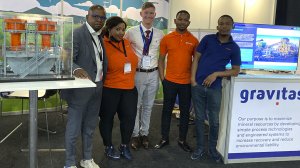

Tech to address excessive fines production



THE TEAM The Gravitas Minerals Team exhibited at the Southern African Coal Processing Society Biennial Conference at the Graceland Casino and Country Club in Secunda, Mpumalanga
OPTIMA CLASSIFIER The Optima Classifier is a water-only density separator
The shift to mechanised mining in the coal industry has had the side-effect of an excessive quantity of fines being produced, which often means that the thickeners deployed in minerals-processing circuits are undersized and cannot cope.
“Eight out of ten coal mines encounter this problem in their operations, mainly owing to the fact that the thickeners are not designed to handle such a large quantity of fines,” highlights Gravitas MD Tebogo Kale.
With this in mind, Minerals Gravitas presented a detailed overview of its latest advances in fine-coal beneficiation, at the Southern African Coal Processing Society (SACPS) Biennial Conference at the Graceland Casino and Country Club in Secunda, Mpumalanga, from October 12 to 14, under the theme of ‘Coal Processing and our Role in the Drive for Cleaner Coal’.
Kale notes that the fact that the transition to renewables as a significant component of South Africa’s energy mix is not going to happen overnight indicates that any advances in clean coal are “critical” to boost environmental awareness in the coal value chain and the impact on the “triple bottom line of people, planet and profit”.
Apart from thickener issues, owing to an overproduction of fines, these also invariably end up in slurry ponds, tailings dams and silt traps, which incurs significant handling, construction and disposal costs when it comes to remediation.
Whereas traditionally, only 10% to 15% of fines went to the thickener, this figure is now 20%.
“The technology we can bring to the table not only mitigates this problem, but results in a commercially viable and sustainable end product. Not only can this high-quality product be exported, it also means that less fines end up in slimes dams, which compounds the environmental impact of coal,” Kale says.
While Kale’s presentation focused on the business case of the technology developed the company, Gravitas associate Franco van de Venter presented a paper in conjunction with metallurgy and processing company Multotec Process Equipment on how the Optima Classifier separator can be used in conjunction with traditional spirals in a fine-coal processing circuit.
Two approaches were evaluated, one where run-of-mine fine coal was fed to the Optima Classifier and one where the Optima discard was fed to a low-cut spiral. In addition, the Optima can also be added to an existing fine coal circuit or mineral preparation plant as a separate module to boost overall recovery and quality.
“We clearly outlined the problems associated with clean coal and the impact from an environmental point of view, as well as outlining a potential solution that can be implemented efficiently and cost-effectively. It is important for the coal industry to advance the cause of clean coal in response to growing environmental concerns about greenhouse-gas emissions and climate change.”
The Optima Classifier is a water-only density separator. It is an engineered system that consists of feed preparation, beneficiation/separation and dewatering modules to ensure a high-quality product with the correct moisture content. Typical products consist of ash below 16% and a calorific value of at least 27-million joules per kilogram. Moisture plays a major role in the fine coal market and the water recovered from the product is immediately reused for processing.
Grain sizes of up to 5 mm can be processed, while unit sizes of up to 150 t/h can be built. The discharge devices are electrically controlled, which presents the opportunity for a total green solution. The fact that the solution does not draw much power, with the Optima Classifier using the same 220 V rating as a typical household appliance, means that renewable energy can easily and effectively be added as the main power source for sustainability.




